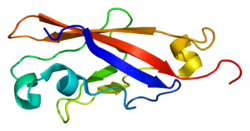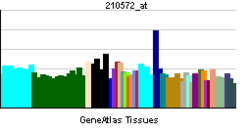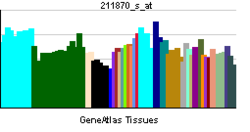- PCDHA3
-
Protocadherin alpha 3 
PDB rendering based on 1wuz.Available structures PDB 1wuz Identifiers Symbols PCDHA3; MGC141669; PCDH-ALPHA3 External IDs OMIM: 606309 MGI: 2447313 HomoloGene: 75096 GeneCards: PCDHA3 Gene Gene Ontology Molecular function • calcium ion binding
• protein bindingCellular component • plasma membrane
• integral to plasma membraneBiological process • cell adhesion
• homophilic cell adhesion
• nervous system developmentSources: Amigo / QuickGO RNA expression pattern 

More reference expression data Orthologs Species Human Mouse Entrez 56145 192163 Ensembl ENSG00000255408 ENSMUSG00000091969 UniProt Q9Y5H8 n/a RefSeq (mRNA) NM_018906.2 NM_138662.1 RefSeq (protein) NP_061729.1 NP_619603.1 Location (UCSC) Chr 5:
140.18 – 140.39 MbChr 18:
37.11 – 37.11 MbPubMed search [1] [2] Protocadherin alpha-3 is a protein that in humans is encoded by the PCDHA3 gene.[1][2]
This gene is a member of the protocadherin alpha gene cluster, one of three related gene clusters tandemly linked on chromosome five that demonstrate an unusual genomic organization similar to that of B-cell and T-cell receptor gene clusters. The alpha gene cluster is composed of 15 cadherin superfamily genes related to the mouse CNR genes and consists of 13 highly similar and 2 more distantly related coding sequences. The tandem array of 15 N-terminal exons, or variable exons, are followed by downstream C-terminal exons, or constant exons, which are shared by all genes in the cluster. The large, uninterrupted N-terminal exons each encode six cadherin ectodomains while the C-terminal exons encode the cytoplasmic domain. These neural cadherin-like cell adhesion proteins are integral plasma membrane proteins that most likely play a critical role in the establishment and function of specific cell-cell connections in the brain. Alternative splicing has been observed and additional variants have been suggested but their full-length nature has yet to be determined.[2]
References
- ^ Wu Q, Maniatis T (Jul 1999). "A striking organization of a large family of human neural cadherin-like cell adhesion genes". Cell 97 (6): 779–90. doi:10.1016/S0092-8674(00)80789-8. PMID 10380929.
- ^ a b "Entrez Gene: PCDHA3 protocadherin alpha 3". http://www.ncbi.nlm.nih.gov/sites/entrez?Db=gene&Cmd=ShowDetailView&TermToSearch=56145.
Further reading
- Nollet F, Kools P, van Roy F (2000). "Phylogenetic analysis of the cadherin superfamily allows identification of six major subfamilies besides several solitary members". J. Mol. Biol. 299 (3): 551–72. doi:10.1006/jmbi.2000.3777. PMID 10835267.
- Yagi T, Takeichi M (2000). "Cadherin superfamily genes: functions, genomic organization, and neurologic diversity". Genes Dev. 14 (10): 1169–80. PMID 10817752.
- Schmutz J, Martin J, Terry A, et al. (2004). "The DNA sequence and comparative analysis of human chromosome 5". Nature 431 (7006): 268–74. doi:10.1038/nature02919. PMID 15372022.
- Strausberg RL, Feingold EA, Grouse LH, et al. (2003). "Generation and initial analysis of more than 15,000 full-length human and mouse cDNA sequences". Proc. Natl. Acad. Sci. U.S.A. 99 (26): 16899–903. doi:10.1073/pnas.242603899. PMC 139241. PMID 12477932. http://www.pubmedcentral.nih.gov/articlerender.fcgi?tool=pmcentrez&artid=139241.
- Wu Q, Zhang T, Cheng JF, et al. (2001). "Comparative DNA sequence analysis of mouse and human protocadherin gene clusters". Genome Res. 11 (3): 389–404. doi:10.1101/gr.167301. PMC 311048. PMID 11230163. http://www.pubmedcentral.nih.gov/articlerender.fcgi?tool=pmcentrez&artid=311048.
- Wu Q, Maniatis T (2000). "Large exons encoding multiple ectodomains are a characteristic feature of protocadherin genes". Proc. Natl. Acad. Sci. U.S.A. 97 (7): 3124–9. doi:10.1073/pnas.060027397. PMC 16203. PMID 10716726. http://www.pubmedcentral.nih.gov/articlerender.fcgi?tool=pmcentrez&artid=16203.
- Sugino H, Hamada S, Yasuda R, et al. (2000). "Genomic organization of the family of CNR cadherin genes in mice and humans". Genomics 63 (1): 75–87. doi:10.1006/geno.1999.6066. PMID 10662547.
PDB gallery Categories:- Human proteins
- Chromosome 5 gene stubs
Wikimedia Foundation. 2010.

